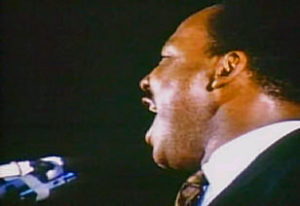 “Like anybody, I would like to live a long life. Longevity has its place. But I’m not concerned about that now. I just want to do God’s will. And He’s allowed me to go up to the mountain. And I’ve looked over. And I’ve seen the Promised Land. I may not get there with you. But I want you to know tonight, that we, as a people, will get to the promised land!” – Martin Luther King, Jr., (from his last speech, I’ve been to the Mountaintop, April 3, 1968)
“Like anybody, I would like to live a long life. Longevity has its place. But I’m not concerned about that now. I just want to do God’s will. And He’s allowed me to go up to the mountain. And I’ve looked over. And I’ve seen the Promised Land. I may not get there with you. But I want you to know tonight, that we, as a people, will get to the promised land!” – Martin Luther King, Jr., (from his last speech, I’ve been to the Mountaintop, April 3, 1968)
Today, April 4, marks fifty years since the tragic assassination of the reverend Martin Luther King, Jr. As part of its commemoration of the event, Memphis held a two-day symposium April 2-3 asking the question: where do we go from here? Unsurprisingly, participants arrived knowing that despite progress over the ensuing half-century, much more remained to be done. They decided that the path forward lies in a rededication to those causes Dr. King espoused: racial equality; reduction of poverty; greater economic equity; better education for all; and more. Time to enter, not just view, the promised land.
Today, meteorologists, and their close kin hydrologists, oceanographers, climatologists, Earth and space scientists, could well ask the same question. Although the particulars include many arcane scientific and technological bits, much of “where do we go from here” is aligned with Dr. King’s broader themes.
Inclusion is a major AMS concern and goal. With the transition in the meteorological profession from forecasts of geophysical conditions per se to impact-based decision support, meteorologists, whether researchers or service providers, find themselves drawn in not just to the social dimensions of their work but also a continuing need to translate “protection of life and property” and “economic development” into both public good and private interest. The act of balancing these two needs changes and grows more challenging with each scientific and technological advance and the unintended consequences for shifts in private and public provision of weather services. Underpinning the prospects for managing these challenges is the state of American public education, especially critical thinking and STEM education. Weather extremes – hurricanes, winter storms, floods, and other natural phenomena – are portal drawing young Americans into scientific fields more broadly.
The value of meteorology to society, but, more importantly, the connection of meteorology to American values?
Worth some reflection today. If as a meteorological community, we model inclusion; through continuing innovation foster public good as well as private interest; and do our bit for STEM education; we can help America and the world toward a more sustainable, vibrant, satisfying and meaningful future.

